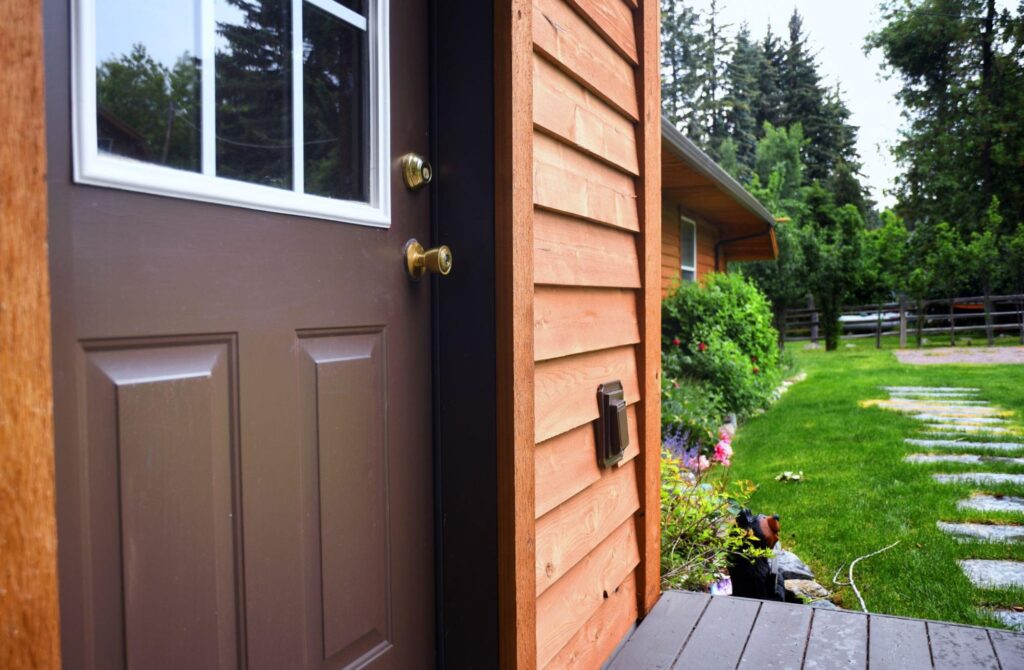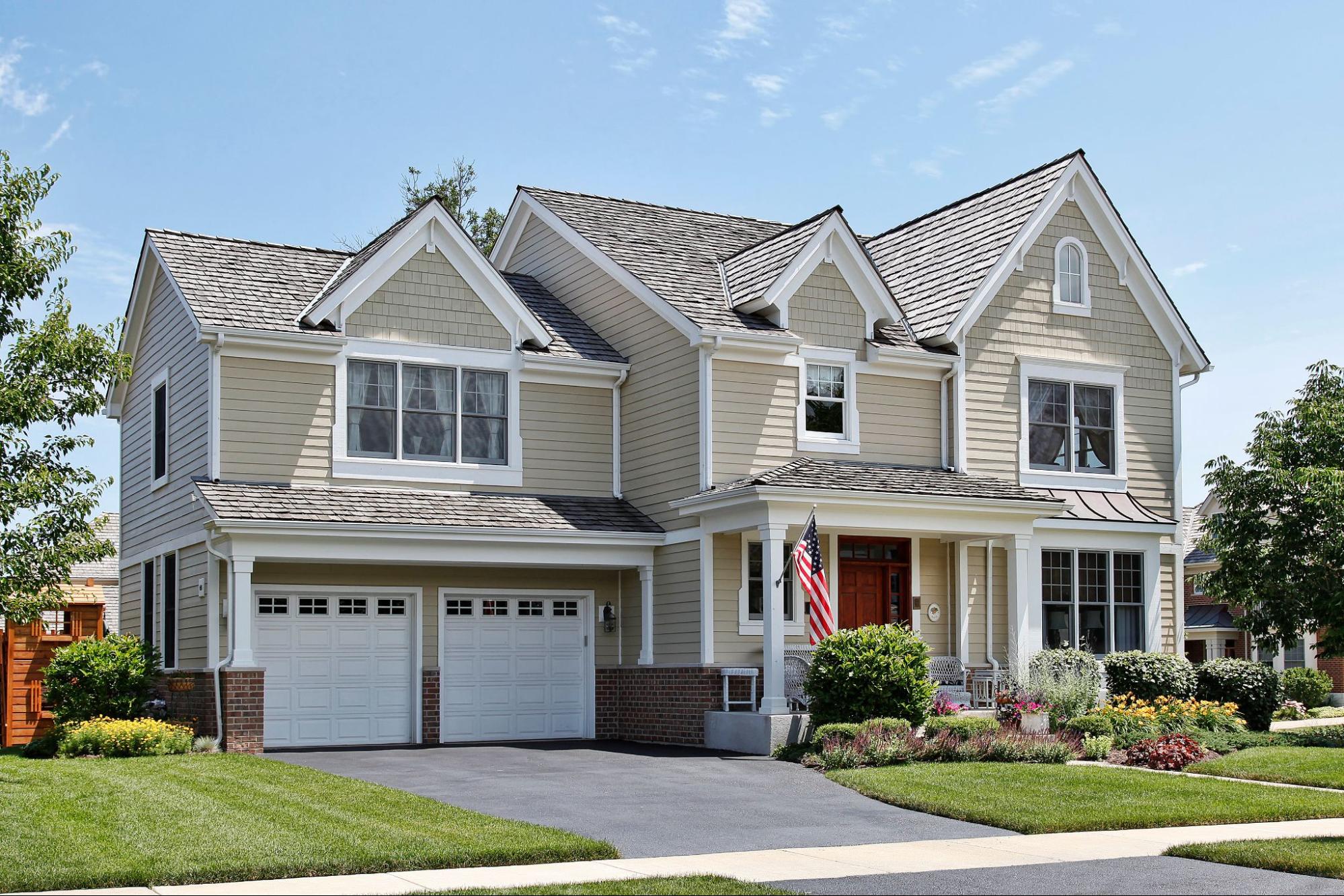Choosing the right siding for your home is a crucial decision. It not only affects the aesthetic appeal of your property but also plays a significant role in its durability and maintenance requirements. Among the plethora of siding options available, two popular choices are engineered wood siding and fiber cement siding.
But when it comes to engineered wood siding vs. fiber cement, which one is the best choice for your home? We’re here to break it down in this guide, delving into the:
- Features
- Pros and cons of each type
- The cost implications
- Longevity
- How to select the ideal siding for your home
What is Engineered Wood Siding?

Engineered wood siding, also known as composite wood siding, is a manufactured product made from wood strands, fibers, or particles bonded together with adhesives and resins. This type of siding mimics the appearance of traditional wood siding but offers improved durability and resistance to decay, insects, and moisture. It’s available in various styles, including clapboard, shingle, and panel designs, providing homeowners with versatile options to suit their preferences.
👍 Pros of Engineered Wood Siding:
- Aesthetic Appeal: Engineered wood siding replicates the natural beauty of wood, offering an authentic and timeless look to your home’s exterior.
- Durability: Unlike traditional wood siding, engineered wood is less susceptible to rot, decay, and insect damage, thanks to its manufacturing process and protective coatings.
- Cost-Effective: Engineered wood siding typically costs less than fiber cement and natural wood siding options, making it an attractive choice for budget-conscious homeowners.
- Easy Installation: Engineered wood siding is lightweight and easy to install, reducing labor costs and installation time compared to heavier materials like fiber cement.
- Low Maintenance: With minimal upkeep requirements, engineered wood siding can be cleaned with soap and water, eliminating the need for costly maintenance tasks.
👎 Cons of Engineered Wood Siding
- Moisture Sensitivity: While engineered wood siding is more resistant to moisture than natural wood, it can still swell or warp if exposed to prolonged moisture, requiring proper sealing and maintenance.
- Susceptibility to Impact Damage: Unlike fiber cement, engineered wood siding is more prone to denting or chipping from impacts such as hail or flying debris.
- Limited Longevity: Although engineered wood siding offers decent durability, it may not last as long as fiber cement or other premium siding materials, potentially requiring replacement sooner.
What is Fiber Cement Siding?

Fiber cement siding is a composite material composed of cement, sand, and cellulose fibers. It’s renowned for its exceptional durability, resistance to fire, pests, and rot, making it a popular choice among homeowners seeking a low-maintenance and long-lasting siding option. Fiber cement siding is available in various textures and styles, including lap siding, vertical panels, and shingles, providing versatility in design options.
👍 Pros of Fiber Cement Siding:
- Exceptional Durability: Fiber cement siding is highly durable and resistant to damage from pests, fire, moisture, and extreme weather conditions, offering long-term protection for your home.
- Low Maintenance: With minimal maintenance requirements, fiber cement siding does not require painting as frequently as wood siding and can be cleaned with soap and water, reducing maintenance costs over time.
- Versatility in Design: Fiber cement siding comes in a wide range of textures, colors, and styles, allowing homeowners to achieve their desired aesthetic while benefiting from the durability of the material.
- Longevity: Fiber cement siding is known for its longevity, with many manufacturers offering warranties ranging from 25 to 50 years, providing peace of mind for homeowners.
👎 Cons of Fiber Cement Siding:
- Higher Cost: Fiber cement siding tends to be more expensive than engineered wood and vinyl siding options, primarily due to its superior durability and longevity.
- Heavyweight: Fiber cement siding is heavier than engineered wood and may require additional structural support during installation, increasing labor and installation costs.
- Professional Installation Required: Due to its weight and specialized installation requirements, fiber cement siding should be installed by experienced professionals, adding to the overall project cost.
Cost Difference Between Engineered Wood Siding and Fiber Cement
When comparing the cost of engineered wood siding and fiber cement siding, several factors come into play, including material costs, installation expenses, and long-term maintenance requirements. On average, fiber cement siding tends to be more expensive upfront due to its superior durability and longevity. However, engineered wood siding may offer cost savings in terms of installation and maintenance over time.
The cost of engineered wood siding typically ranges from $5 to $10 per square foot, including materials and installation. In contrast, fiber cement siding averages between $8 to $12 per square foot, making it a pricier option upfront. Additionally, the complexity of the installation, the size of the project, and any additional features or customization can impact the overall cost of both siding options.
Which One Lasts Longer: Engineered Wood Siding or Fiber Cement?
When it comes to longevity, fiber cement siding has a slight edge over engineered wood siding. Fiber cement siding is renowned for its exceptional durability and resistance to damage from pests, fire, moisture, and extreme weather conditions. Many manufacturers offer warranties ranging from 25 to 50 years for fiber cement siding, providing homeowners with peace of mind and long-term protection for their investment.
On the other hand, while engineered wood siding offers decent durability and resistance to decay, it may not last as long as fiber cement siding. Engineered wood siding is more susceptible to moisture damage, impact damage, and general wear and tear over time, potentially requiring replacement or repair sooner than fiber cement siding. However, with proper maintenance and care, engineered wood siding can still provide reliable performance and aesthetic appeal for many years.
How to Choose the Right Siding for Your Home
Choosing the right siding for your home involves considering various factors, including your budget, aesthetic preferences, climate, maintenance requirements, and long-term durability. Here are some key considerations to help you make an informed decision:
- Budget: Determine your budget for the siding project, including material costs, installation expenses, and long-term maintenance requirements. Compare the costs of engineered wood siding and fiber cement siding to determine which option best fits your budget.
- Aesthetic Preferences: Consider the architectural style of your home and your aesthetic preferences when choosing siding materials, colors, and textures. Both engineered wood siding and fiber cement siding offer versatile design options to complement various home styles.
- Climate and Environmental Factors: Take into account the climate and environmental conditions in your area, including exposure to moisture, extreme temperatures, and potential impact damage. Choose siding materials that offer adequate protection and resistance to weather-related damage.
- Durability and Longevity: Evaluate the durability and longevity of different siding materials based on manufacturer warranties, material composition, and resistance to pests, fire, moisture, and other environmental factors. Consider the expected lifespan of the siding and weigh the long-term value of your investment.
- Maintenance Requirements: Assess the maintenance requirements of each siding option, including cleaning, painting, sealing, and repair. Choose siding materials that offer low maintenance requirements and long-term durability to minimize upkeep costs and efforts.
- Professional Installation: Factor in the cost and expertise required for professional installation of the siding materials. While some homeowners may opt for DIY installation, complex siding projects, such as fiber cement siding, may require professional installation to ensure proper fit, performance, and warranty coverage.
When to Replace Your Siding:
Knowing when to replace your siding is essential for maintaining the integrity and curb appeal of your home. Several signs indicate that it may be time to replace your siding, including:
Visible Damage:
Inspect your siding for signs of damage, such as cracks, warping, rot, decay, or insect infestation. Damaged siding can compromise the structural integrity of your home and lead to further issues if not addressed promptly.
Fading or Peeling Paint:
If your siding is showing signs of fading, peeling paint, or discoloration, it may be time for a refresh. Repainting or replacing the siding can enhance the aesthetic appeal of your home and protect it from further damage.
Increased Energy Bills:
Poorly insulated or damaged siding can result in energy loss and higher utility bills. If you notice a significant increase in energy costs or drafts inside your home, consider replacing your siding with more energy-efficient materials.
Mold or Mildew Growth:
Excessive moisture or humidity can lead to mold or mildew growth on your siding, indicating a potential moisture problem. Addressing the underlying cause of moisture intrusion and replacing damaged siding can prevent further mold-related issues.
Age of Siding:
Consider the age of your siding and its expected lifespan when determining whether to replace it. While some siding materials may last for decades with proper maintenance, others may deteriorate more quickly and require replacement sooner.
Get the Right Siding Material for Your Home
Choosing between engineered wood siding and fiber cement siding involves weighing the pros and cons of each option, considering factors such as cost, durability, maintenance requirements, and aesthetic preferences. Both siding materials offer unique advantages and can enhance the curb appeal and value of your home when installed properly.
Contact the Open Box team to get a professional siding consultation for your home!






